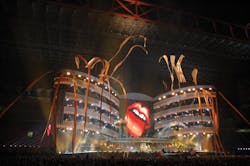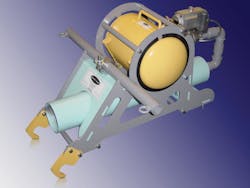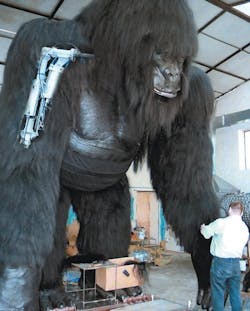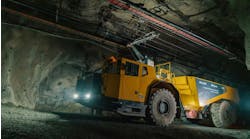The Rolling Stones' latest world tour, A Bigger Bang, has broken multiple records for duration and audience numbers, and features spectacular stage effects that rely on the innovative use of pneumatics technology. A Bigger Bang started in Toronto in August 2005. Since then, the Rolling Stones has performed in front of sell-out audiences 116 times at 103 different venues around the world, spanning North and South America, the Asia-Pacific region, and Europe. The tour culminated in Vancouver on November 25, 2006.
Hailed by many as the world's greatest rock ‘n roll band, the Rolling Stones is renowned for its high quality, dynamic performances — making each successive tour series a harder act to follow. For the Bigger Bang tour, Mark Fisher, the Stones' stage set and production designer, was presented the challenge of coming up with a finale for the close of each show. In addition to the explosion of sound normally created by pyrotechnics at Stones' concerts, it was decided that each concert should end with a spectacular display of movement. Fisher and the contractors of the stage set, Brilliant Stages Ltd., Hitchin, England, chose to investigate whether pneumatics could provide the necessary dynamics. In doing so, they sought the help of automation specialist Parker Hydraulics & Pneumatics, Norwich, England, to develop the system.
Summarizing the solution
As part of the finale, 36 air cannons — accompanied by explosive sounds — fire hundreds of 30-m ribbons into the air from the top of the stage set. Each cannon consists of a 20-l reservoir charged with up to 4 to 6 bar of compressed air. Upon command, a rotary actuator opens a ball valve, which instantly routes compressed air from the reservoir into the barrel of the cannon. This 1-m long, 15-cm bore cannon barrel is packed with the multicolored ribbons. Therefore, when the command is given to fire each cannon, a blast of air propels thousands of multi-colored ribbons skyward.
Parker Hydraulics & Pneumatics specified Festo components for all the pneumatic control functions. They are an approved Festo Premier Stockist and knew that Festo's electropneumatically actuated ball valves offered an ideal means of controlling the output from the cannons' air reservoirs.
Ball valves were chosen for their high flow capacity — when fully open, they provide an open flow path — so air can flow unrestricted from the reservoir to the cannon barrel. Ball valves also can accommodate high pressure, so they easily accommodate the 6-bar maximum charge pressure of the reservoirs. Furthermore, Festo's ball valve design features an inherently safe, blow-out proof shaft that is assembled from the inside of the component.
Each ball valve is driven by a quarter-turn pneumatic actuator, which provides rapid response time, from a NAMUR series solenoid valve. NAMUR is an international mounting configuration that allows the solenoid valve to be bolted over the supply ports of a single-acting spring-return or double-acting pneumatic actuator.
The actuator itself features a scotch yoke mechanism* that produces high initial torque for rapid shifting of the ball valve. The solenoid for each valve is wired back to the stage set's main sound and effects management desk and triggered manually when required. Pilot pressure to operate the actuator comes from a tee in the line between the reservoir and the ball valve. The amount of compressed air for actuating the valve is negligible compared to that needed to launch the cannon.
According to Tony Bowern, General Manager of Brilliant Stages, "The performance of our new air cannons has far exceeded expectations. The sound they make is quite incredible, and the visual affect is superb! The system provides a dramatic audio-visual finale for each concert and has proved remarkably robust, having performed flawlessly on every occasion."
For more information, contact Parker Hydraulics & Pneumatics at www. parkerhydraulics.co.uk. Contact Festo Corp. in the U. S. at (631) 4350800 or visit www.festo.com. Brilliant Stages can be reached at www.brilliant stages.com
* Click here for details on scotch yoke and other types of rotary actuators from the Fluid Power Basics section of our website.
A tall order for pneumatics
Air cannons represent an application that intermittently and suddenly uses large quantities of compressed air to move a load. In contrast, the animated gorilla shown at right uses pneumatics for continuous motion and force control. Festo supplied multiple components that give life to this 8-m high 2-ton gorilla.
The gorilla pounds its chest and produces facial expressions. Silicone skin covered with Mongolian wool has been peeled away to reveal a pair of pneumatic cylinders that articulate the right upper arm. The figure was manufactured by NPO Ltd., of Semipalatinsk, Kazakhstan.




